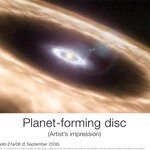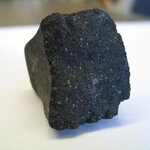Space

Natarajan found that ultra-massive black holes, which lurk in the centers of huge galaxy clusters like the one above, seem to have an upper mass limit of 10 billion times that of the Sun. (Credit: NASA)
There appears to be an upper limit to how big the universe’s most massive black holes can get, according to new research led by Yale University astrophysicist Priyamvada Natarajan and Ezequiel Treister, a postdoctoral fellow at the University of Hawaii.
Once considered rare and exotic objects, black holes are now known to exist throughout the universe, with the largest and most massive…

Burst Alert! March 19th was an exciting day for NASA. We know “why” it was special, but we don’t know “why why” it was special. They finally explain the why why today, and you can read all about it in Nature tomorrow.
There was something amazing about GRB 080319B and the other cosmic bursts that NASA’s Swift satellite detected that day. (See NASA's animation of what they think happened).
"Even by the standards of gamma-ray bursts, this burst was a whopper," says Swift lead scientist Neil Gehrels of NASA. "It blows away every gamma ray burst we’ve seen so far."
Here’s the why (we'll get to the…

What do you call a supernova that is not as powerful and doesn't destroy the star?
A babynova? Subnova?
We'll need to think of something, according to Berkeley astronomer Nathan Smith, because that is what happened in 1843 to Eta Carinae, the galaxy's second most studied star.
Eta Carinae (η Car) is a massive, hot, variable star visible only from the Southern Hemisphere, and is located about 7,500 light years from Earth in a young region of star birth called the Carina Nebula. It was observed to brighten immensely in 1843, and astronomers now see the resulting cloud of gas and dust, known as…

GRB 080319B was so intense that, despite happening halfway across the Universe, it could have been seen briefly with the unaided eye. In a Nature paper, Judith Racusin of Penn State University, and a team of 92 co-authors report observations across the electromagnetic spectrum that began 30 minutes before the explosion and followed it for months afterwards.
"We conclude that the burst's extraordinary brightness arose from a jet that shot material almost directly towards Earth at almost the speed of light - the difference is only 1 part in 20 000," says Guido Chincarini, a member of the team…

Astronomers have been able to study planet-forming discs around young Sun-like stars in unsurpassed detail, clearly revealing the motion and distribution of the gas in the inner parts of the disc. This result, which possibly implies the presence of giant planets, was made possible by the combination of a very clever method enabled by ESO's Very Large Telescope.
Planets could be home to other forms of life, so the study of exoplanets ranks very high in contemporary astronomy. More than 300 planets are already known to orbit stars other than the Sun, and these new worlds show an amazing…

When scientific terms become part of the cultural fabric they often lose their meaning. Biology has had its share of modern misunderstandings with 'evolution' becoming colloquial rather than scientific, along with the general term 'theory', which today is used by anyone with a crackpot notion about particle physics, math or the end of the world due to a tunnel in Switzerland.
So it goes. That's why today we have advertising claims like 'the next evolution in cars' and then press releases about the 'missing link' in comets.
Hey, we don't shape the culture, we just try to cut through it. So…

A strange mix of oxygen found in a stony meteorite that exploded February 8, 1969 over Pueblito de Allende, Mexico has puzzled scientists ever since. Small flecks of minerals lodged in the stone and thought to date from the beginning of the solar system have a pattern of oxygen types, or isotopes, that differs from those found in all known planetary rocks, including those from Earth, its Moon and meteorites from Mars.
Now scientists from UC San Diego and Lawrence Berkeley National Laboratory have eliminated one model proposed to explain the anomaly: the idea that light from the early Sun…

Astronomers have taken the closest look ever at the giant black hole in the center of the Milky Way. By combining telescopes in Hawaii, Arizona, and California, they detected structure at a tiny angular scale of 37 micro-arcseconds - the equivalent of a baseball seen on the surface of the moon, 240,000 miles distant. These observations are among the highest resolution ever done in astronomy.
Using a technique called Very Long Baseline Interferometry (VLBI), a team of astronomers led by Doeleman employed an array of telescopes to study radio waves coming from the object known as Sagittarius A…

ESO's Wide Field Imager has captured the intricate swirls of the spiral galaxy Messier 83, a smaller look-alike of our own Milky Way. Shining with the light of billions of stars and the ruby red glow of hydrogen gas, it is a beautiful example of a barred spiral galaxy, whose shape has led to it being nicknamed the Southern Pinwheel.
This dramatic image of the galaxy Messier 83 was captured by the Wide Field Imager at ESO's La Silla Observatory, located high in the dry desert mountains of the Chilean Atacama Desert. Messier 83 lies roughly 15 million light-years away towards the huge southern…

Another piece of the jigsaw in understanding how neutron stars work has been put in place following the discovery by scientists of the origin of the high energy emission from rotation-powered pulsars.
Pulsar systems containing neutron stars accelerate particles to immense energies, typically one hundred times more than the most powerful accelerators on Earth. Scientists are still uncertain exactly how these systems work and where the particles are accelerated.
Now a team of researchers from the UK and Italy, led by Professor Tony Dean of the University of Southampton, has detected polarized…